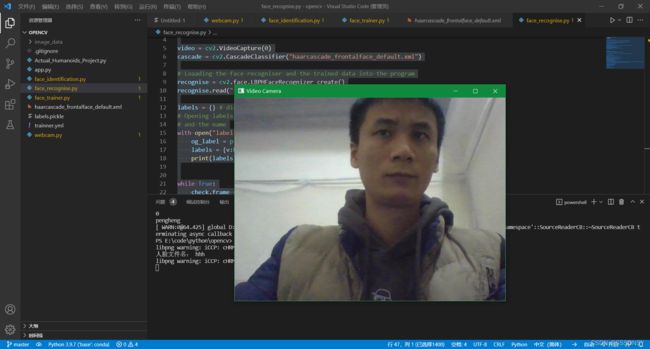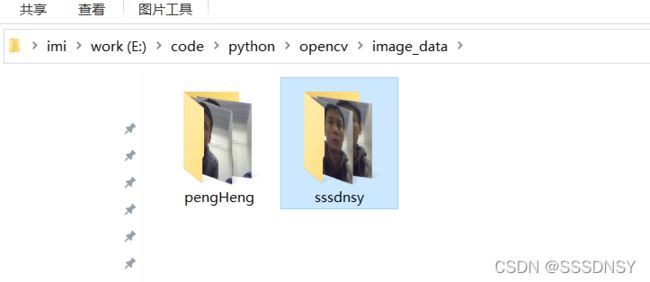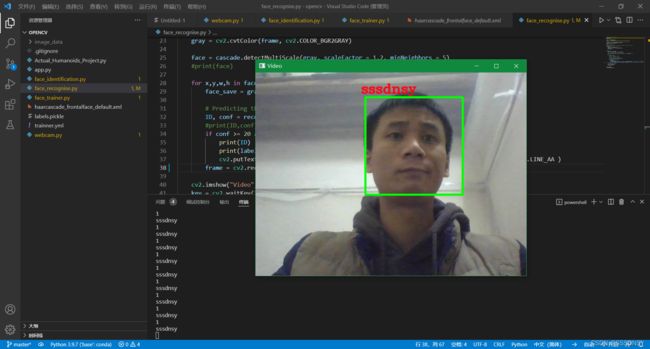一起来玩人脸识别教程(python3+openCV 3步完成)
1、调用电脑摄像头 cam.py
# import opencv library
from fileinput import filename
from pyparsing import Char
from tkinter.simpledialog import askinteger,askfloat,askstring
import cv2
import tkinter as tk
import tkinter.simpledialog
import os
# Create a VideoCapture() object as "video"
video = cv2.VideoCapture(0)
# Index of you captured images
idx=1
#save folder name for person
root = tk.Tk()
root.withdraw()
faceName=askstring("提示",'输入保存的人脸名称:')
print("人脸文件名:",faceName)
# Enter into an infinite while loop
while True:
# Data of 1 frame is read every time when this while loop is repeated
# into the variable frame
# check contains the boolean value i.e True or False if its True then
# webcam is active
check,frame = video.read()
# imshow is a method of cv2 library which will basically show the image
# or frame on a new window
cv2.imshow("Video Camera",frame)
# Creates a delay of 1 mili-second and stores the value to variable key
# if any key is pressed on keyboard
key = cv2.waitKey(1)
# check if key is equal to 'q' if it is then break out of the loop
if(key == ord('q')):
print("bye!")
break
if(key == ord(' ')):
print("you press btn: space save image ,index=",idx)
path=os.path.join("image_data", faceName)
if( not os.path.exists(path) ):
os.makedirs(path)
print("path",path,"创建成功")
filename=os.path.sep.join([path, "test_{}.jpg".format(idx)])
cv2.imwrite(filename, frame)
idx+=1
# Release the webcam. in other words turn it of
video.release()
# Destroys all the windows which were created
cv2.destroyAllWindows()
2.训练 train.py 如下,文件:haarcascade_frontalface_default.xml(百度吧)
# import the required libraries
import cv2
import os
import numpy as np
from PIL import Image
import pickle
cascade = cv2.CascadeClassifier("haarcascade_frontalface_default.xml")
recognise = cv2.face.LBPHFaceRecognizer_create()
# Created a function
def getdata():
current_id = 0
label_id = {} #dictionanary
face_train = [] # list
face_label = [] # list
# Finding the path of the base directory i.e path were this file is placed
BASE_DIR = os.path.dirname(os.path.abspath(__file__))
# We have created "image_data" folder that contains the data so basically
# we are appending its path to the base path
my_face_dir = os.path.join(BASE_DIR,'image_data')
# Finding all the folders and files inside the "image_data" folder
for root, dirs, files in os.walk(my_face_dir):
for file in files:
# Checking if the file has extention ".png" or ".jpg"
if file.endswith("png") or file.endswith("jpg"):
# Adding the path of the file with the base path
# so you basically have the path of the image
path = os.path.join(root, file)
# Taking the name of the folder as label i.e his/her name
label = os.path.basename(root).lower()
# providing label ID as 1 or 2 and so on for different persons
if not label in label_id:
label_id[label] = current_id
current_id += 1
ID = label_id[label]
# converting the image into gray scale image
# you can also use cv2 library for this action
pil_image = Image.open(path).convert("L")
# converting the image data into numpy array
image_array = np.array(pil_image, "uint8")
# identifying the faces
face = cascade.detectMultiScale(image_array)
# finding the Region of Interest and appending the data
for x,y,w,h in face:
img = image_array[y:y+h, x:x+w]
#image_array = cv2.rectangle(image_array,(x,y),(x+w,y+h),(255,255,255),3)
cv2.imshow("Test",img)
cv2.waitKey(1)
face_train.append(img)
face_label.append(ID)
# string the labels data into a file
with open("labels.pickle", 'wb') as f:
pickle.dump(label_id, f)
return face_train,face_label
# creating ".yml" file
face,ids = getdata()
recognise.train(face, np.array(ids))
recognise.save("trainner.yml")
3、识别标记
# import the required libraries
import cv2
import pickle
video = cv2.VideoCapture(0)
cascade = cv2.CascadeClassifier("haarcascade_frontalface_default.xml")
# Loaading the face recogniser and the trained data into the program
recognise = cv2.face.LBPHFaceRecognizer_create()
recognise.read("trainner.yml")
labels = {} # dictionary
# Opening labels.pickle file and creating a dictionary containing the label ID
# and the name
with open("labels.pickle", 'rb') as f:##
og_label = pickle.load(f)##
labels = {v:k for k,v in og_label.items()}##
print(labels)
while True:
check,frame = video.read()
gray = cv2.cvtColor(frame, cv2.COLOR_BGR2GRAY)
face = cascade.detectMultiScale(gray, scaleFactor = 1.2, minNeighbors = 5)
#print(face)
for x,y,w,h in face:
face_save = gray[y:y+h, x:x+w]
# Predicting the face identified
ID, conf = recognise.predict(face_save)
#print(ID,conf)
if conf >= 20 and conf <= 115:
print(ID)
print(labels[ID])
cv2.putText(frame,labels[ID],(x-10,y-10),cv2.FONT_HERSHEY_COMPLEX ,1, (18,5,255), 2, cv2.LINE_AA )
frame = cv2.rectangle(frame, (x,y), (x+w,y+h),(0,255,255),4)
cv2.imshow("Video",frame)
key = cv2.waitKey(1)
if(key == ord('q')):
break
video.release()
cv2.destroyAllWindows()
4、学习记录
Face-Recognition


